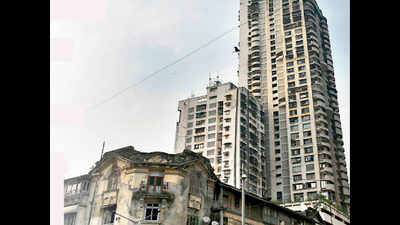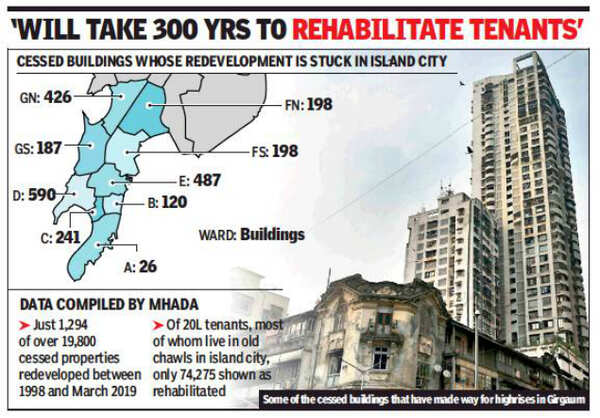- News
- City News
- mumbai News
- Mumbai: 50,000 families stuck in cessed buildings as redevelopment stalls
Trending
This story is from November 21, 2019
Mumbai: 50,000 families stuck in cessed buildings as redevelopment stalls
Information compiled by Mhada shows 2,152 redevelopment projects involving cessed properties in the island city were issued no-objection certificates (NOCs) over the years but only 778 of them were completed. Mhada cancelled the NOCs in 46 cases, comprising 111 buildings and 2,064 tenants. Another 51,321 families living in cessed properties are stuck as their redevelopment projects have failed to take off.

Some of the cessed buildings that have made way for highrises in Girgaum
MUMBAI: Information compiled by Mhada shows 2,152 redevelopment projects involving cessed properties in the island city were issued no-objection certificates (NOCs) over the years but only 778 of them were completed. Mhada cancelled the NOCs in 46 cases, comprising 111 buildings and 2,064 tenants. Another 51,321 families living in cessed properties are stuck as their redevelopment projects have failed to take off.

“At this rate, it will take almost 300 years to rehabilitate all the tenants.The scheme has been a failure, mainly because it was effectively used to oust tenants resulting in a trust-deficit between tenants and builders,” said housing activist Chandrashekhar Prabhu.
The controversial policy saw an increase in FSI over the years with the maximum given by the then Shiv Sena-BJP government under chief minister Manohar Joshi in late 1990s.
Harresh Mehta, once considered the biggest builder redeveloping cessed properties in south Mumbai, told TOI: “Nine out of 10 developers have gone out of business and most redevelopment projects involving dilapidated cess buildings have become financially unviable.”
Developer Murtuza Ali of Alamdar Infrastructure, who has several such projects under his belt, said he has been unable to sell even small 1BHK flats in the free sale component of his buildings. “Due to poor market conditions, 25% of our inventory remains unsold,” he added.
Mehta, who claims to control over 50 cessed properties in the island city, said heavy premiums, taxes, GST, stringent RERA rules and funds drying up from financial institutions have stalled redevelopment projects. “Besides, there is no faith in the market,” he said.
Another developer said, “Obviously, there are more buildings which are still to be redeveloped, but that will happen gradually. These buildings are largely located in south and central Mumbai, where the market is slow.”
Popularly known as 33 (7), the scheme has been plagued by allegations of building violations and bogus and inflated tenants’ list shown by builders so that they get more FSI to build.
The policy had also led to widespread criticism among activists and town planners because it allowed skyscrapers to come up on narrow plots with zero open space in congested localities of the island city. Perennially crowded areas such as Girgaum, Grant Road, Bhuleshwar, Nagpada and Parel saw a proliferation of such skyscrapers.
In 2017, NGO Janhit Manch prepared a report showing how several builders redeveloping old and dilapidated cessed buildings allegedly misused FSI by showing bogus tenants so they could build higher buildings consuming unlimited floor spaces.
The report, which was submitted to the state government, confirmed what was long common knowledge-—builders inflate the list of tenants to be rehabilitated free of cost in new buildings. The higher the number of tenants, the more FSI the builders get.
“Newly created bogus tenants are allotted premises only on paper to comply with the Mhada NOC. These tenants never get physical possession of any premises. The premises are actually sold to outsiders at market rate,” said the NGO.
In Malabar Hill and Nepean Sea Road, many such buildings have been constructed and are now occupied by the super-rich.
“More apartments for sale in the market are achieved by creating non-existent and fictitious occupants,” it said.

“At this rate, it will take almost 300 years to rehabilitate all the tenants.The scheme has been a failure, mainly because it was effectively used to oust tenants resulting in a trust-deficit between tenants and builders,” said housing activist Chandrashekhar Prabhu.
The controversial policy saw an increase in FSI over the years with the maximum given by the then Shiv Sena-BJP government under chief minister Manohar Joshi in late 1990s.
Builders were offered virtually unlimited floor space index (FSI) to redevelop old tenanted properties. FSI is the ratio that determines how much floor space can be consumed by buildings, resulting in highest densities and tallest buildings.
Harresh Mehta, once considered the biggest builder redeveloping cessed properties in south Mumbai, told TOI: “Nine out of 10 developers have gone out of business and most redevelopment projects involving dilapidated cess buildings have become financially unviable.”
Developer Murtuza Ali of Alamdar Infrastructure, who has several such projects under his belt, said he has been unable to sell even small 1BHK flats in the free sale component of his buildings. “Due to poor market conditions, 25% of our inventory remains unsold,” he added.
Mehta, who claims to control over 50 cessed properties in the island city, said heavy premiums, taxes, GST, stringent RERA rules and funds drying up from financial institutions have stalled redevelopment projects. “Besides, there is no faith in the market,” he said.
Another developer said, “Obviously, there are more buildings which are still to be redeveloped, but that will happen gradually. These buildings are largely located in south and central Mumbai, where the market is slow.”
Popularly known as 33 (7), the scheme has been plagued by allegations of building violations and bogus and inflated tenants’ list shown by builders so that they get more FSI to build.
The policy had also led to widespread criticism among activists and town planners because it allowed skyscrapers to come up on narrow plots with zero open space in congested localities of the island city. Perennially crowded areas such as Girgaum, Grant Road, Bhuleshwar, Nagpada and Parel saw a proliferation of such skyscrapers.
In 2017, NGO Janhit Manch prepared a report showing how several builders redeveloping old and dilapidated cessed buildings allegedly misused FSI by showing bogus tenants so they could build higher buildings consuming unlimited floor spaces.
The report, which was submitted to the state government, confirmed what was long common knowledge-—builders inflate the list of tenants to be rehabilitated free of cost in new buildings. The higher the number of tenants, the more FSI the builders get.
“Newly created bogus tenants are allotted premises only on paper to comply with the Mhada NOC. These tenants never get physical possession of any premises. The premises are actually sold to outsiders at market rate,” said the NGO.
In Malabar Hill and Nepean Sea Road, many such buildings have been constructed and are now occupied by the super-rich.
“More apartments for sale in the market are achieved by creating non-existent and fictitious occupants,” it said.
End of Article
FOLLOW US ON SOCIAL MEDIA










